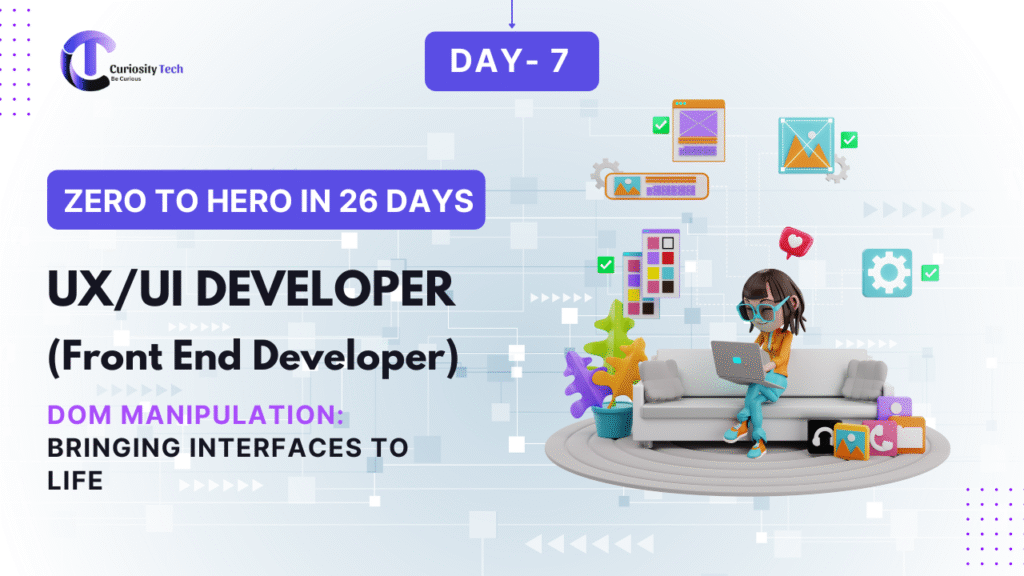When you think about UI/UX development, HTML structures the skeleton, CSS dresses it up, but JavaScript breathes life into the interface. A button that responds instantly, a dropdown that feels smooth, or a slider that syncs perfectly with user interaction—all of these exist because of JavaScript.
As a UI/UX developer, understanding JavaScript is not just an option—it’s a must-have skill. It bridges design with functionality and ensures that user interactions are seamless, accessible, and delightful.
At CuriosityTech, where we continuously train and mentor aspiring frontend developers, we’ve seen one pattern: those who master JavaScript fundamentals early, go on to craft user experiences that stand out in today’s competitive digital landscape.
Why JavaScript Matters in UI/UX Development
- Interactivity: Without JavaScript, interfaces remain static. From form validations to animations, it creates dynamic experiences.
- User-Centered Design: UX thrives on responsiveness. JavaScript helps tailor experiences to the user—real-time feedback, adaptive navigation, and conditional rendering.
- Bridging Design and Engineering: It’s not just about looks; JavaScript ensures designs are functional across browsers and devices.
Essential JavaScript Fundamentals Every UI/UX Developer Should Know
Let’s dive deep into the fundamentals that act as building blocks for an interactive frontend developer career.
1. Variables & Data Types
- Variables store data.
- JavaScript supports primitive data types: string, number, boolean, null, undefined, symbol, and complex ones like object and array.
📌 Pro Tip: Always prefer let and const over var for better scope management.
2. Functions & Scope
Functions are the backbone of interactivity. They help you group reusable logic.
- Function Declaration
function greetUser(name) {
return `Hello, ${name}`;
}
- Arrow Function (modern, concise)
const greetUser = (name) => `Hello, ${name}`;
📌 UI/UX Example: A function that validates form input before submission.
3. DOM Manipulation
The Document Object Model (DOM) is your gateway to designing interactive elements.
- Selecting Elements:
document.querySelector(“.btn”)
- Changing Content:
document.getElementById(“title”).innerText = “Welcome to CuriosityTech!”;
📌 UI/UX Example: Real-time search bars where results appear as you type.
4. Events & Event Handling
Users interact through clicks, scrolls, hovers, and keystrokes.
document.querySelector(“.btn”).addEventListener(“click”, () => {
alert(“Button clicked!”);
});
📌 UI/UX Example: Microinteractions like hover effects and smooth transitions.
5. Objects & Arrays
Data handling is crucial for UI/UX developers.
const user = { name: “Aditi”, age: 23 };
const colors = [“red”, “blue”, “green”];
📌 UI/UX Example: Storing theme colors or user preferences for personalization.
6. Control Structures
if-else, switch, for, while—they let you control user journeys dynamically.
📌 UI/UX Example: Conditional rendering—showing different buttons for logged-in vs guest users.
7. Asynchronous JavaScript (Promises, async/await)
For real-time updates like live chat, API calls, or fetching content.
async function fetchData() {
const response = await fetch(“https://api.example.com/data”);
const data = await response.json();
console.log(data);
}
📌 UI/UX Example: Auto-updating dashboards at CuriosityTech that keep users engaged.


How CuriosityTech Guides Developers
At CuriosityTech, we not only teach JavaScript fundamentals but also emphasize practical application. Our team works on real-world projects—from responsive landing pages to enterprise dashboards. Students and developers here get exposure to building interfaces that scale and delight users, ensuring their skills match global UI/UX standards.
You can always connect with our community through our digital touchpoints like Instagram, LinkedIn, or Facebook, where we share daily insights, career tips, and project showcases.
Conclusion
JavaScript is more than just a programming language—it’s the engine of user experience. For UI/UX developers, mastering the fundamentals is like learning the alphabet before writing novels. From form validation to complex asynchronous interactions, these concepts lay the foundation for crafting intuitive, human-centered interfaces.
At CuriosityTech, we believe that every click, scroll, and hover tells a story. And JavaScript is the scriptwriter that makes this story come alive for users.

